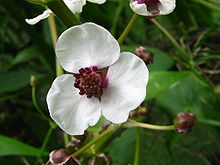- Sagittaria sagittifolia
-
Sagittaria sagittifolia 
Scientific classification Kingdom: Plantae (unranked): Angiosperms (unranked): Monocots Order: Alismatales Family: Alismataceae Genus: Sagittaria Species: S. sagittifolia Binomial name Sagittaria sagittifolia
L.Sagittaria sagittifolia (also called arrowhead due to the shape of its leaves) is a flowering plant in the family Alismataceae, native to wetlands throughout the temperate regions of Europe and Asia; in Britain it is the only native Sagittaria.
It is a herbaceous perennial plant, growing in water from 10-50 cm deep. The leaves above water are arrowhead-shaped, the leaf blade 15-25 cm long and 10-22 cm broad, on a long petiole holding the leaf up to 45 cm above water level. The plant also has narrow linear submerged leaves, up to 80 cm long and 2 cm broad. The flowers are 2-2.5 cm broad, with three small sepals and three white petals, and numerous purple stamens.
Contents
Cultivation and uses
The round tuber is edible. In China, it is known as cigu (Chinese: 慈菇; pinyin: cígū; literally "benevolent mushroom"), and its tuber is eaten particularly on the Chinese New Year. It tastes bland, with a starchy texture, similar to a potato but somewhat crunchier, even when cooked.
Remnants of Sagittaria sagittifolia have been found in the Paleolithic/Mesolithic site of Calowanie in Poland.[1]
Seven new ent-rosane diterpenoids and a new labdane diterpene were recently (2006) purified from the Chinese medicinal plant, Sagittaria sagittifolia (Alismaceae). Four of these compounds (Sagittine A–D) exhibited antibacterial activity against Streptococcus mutans and Actinomyces naeslundii while another (Sagittine E) was only active against A. naeslundii (MIC = 62.5 μg ml–1). Recently, the same group identified five new diterpenoids from Sagittaria pygmaea. None of these displayed activity against A. actinomycetemcomitans, while four of the others were active against A. viscosus and three were active against S. mutans, of which 18-ß-D-3',6'-diacetoxyglucopyranosyl-ent-kaur-16-ene was the most active.[2]
See also
References
- ^ Kubiak-Martens, Lucyna (1996). "Evidence for possible use of plant foods in Palaeolithic and Mesolithic diet from the site of Całowanie in the central part of the Polish Plain". Vegetation History and Archaeobotany 5 (1-2): 33–38. doi:10.1007/BF00189433. http://www.springerlink.com/content/aj286518013457n7/.
- ^ B.Parimala Devi et al. / Journal of Pharmacy Research 2009, 2(11),1669-1675 http://jpronline.info/article/view/906/708
External links
Categories:- Sagittaria
- Root vegetables
- China stubs
- Monocot stubs
- Vegetable stubs
Wikimedia Foundation. 2010.

